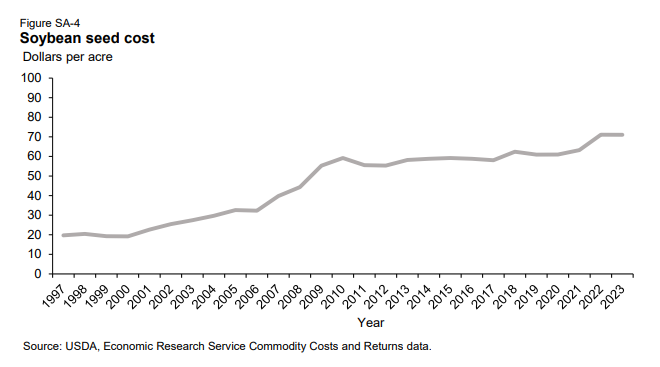Beef prices are projected to continue increasing as U.S. beef production declines with no signs of a cattle herd rebuild. Additionally, cheap beef may soon become further out of reach…
US Soybean Seed Costs Have Risen 260% Since 1997
The USDA Economic Research Service’s Bryn Swearingen and Kate Vaiknoras reported earlier this week that the cost of soybean seeds per acre in the United States has risen more than 260% since 1997, while total soybean production costs have risen 157%.
“In 1997, U.S. farmers spent an average of $19.72 per acre on soybean seeds,” Swearingen and Vaiknoras reported. “That expense rose by more than 260 percent by 2023, when U.S. farmers were spending $71.03 per acre on soybean seeds. Much of the cost increases occurred during 1997–2010, when seed costs increased by 200 percent to $59.20 per acre. Meanwhile, total (soybean) production costs also increased from $245.83 per acre in 1997 to $632.22 per acre in 2023.”

Technological Advancements Have Driven Cost Increases
Swearingen and Vaiknoras attributed much of the increased cost of soybean seeds over the 1997 to 2023 time period to “changes in planting methods, seeding technologies and seed quality.”
“In the mid-1990s, seed companies began selling genetically engineered soybean seeds to U.S. farmers,” Swearingen and Vaiknoras reported. “In 1997, regional adoption rates for these genetically engineered soybean seeds ranged from 8 to 21 percent. In 2002, adoption still varied by region but had jumped from 60 to 96 percent. By 2006 and in remaining survey years, U.S. farmers had planted genetically engineered soybean seeds on at least 93 percent of acres in all regions”
“In more recent years, farmers can purchase soybean seeds with stacked resistance to multiple herbicides,” Swearingen and Vaiknoras reported. “Seeds have also been treated directly with pesticides as a pest management strategy. In addition, precision agriculture (which, through the automation of some farming tasks, can allow farmers to vary the rate of several inputs including seeds) has become increasingly popular. These technological advancements have increased the quality and reliability of the seeds.”
“Possibly and partly due to these technological advancements and higher quality seeds, soybean seeds have become more costly in recent years,” they reported.
Seeding Rates Have Decreased
While prices have increased for soybean seeds since 1997, the seeding rate has decreased across the United States.
Swearingen and Vaiknoras reported that “seeding rates fell in every major soybean-producing State” from 1997 to 2018. “The leading soybean-producing States of Iowa and Illinois fell by 18 and 35 percent, respectively. Whereas some smaller producing States, such as Mississippi and Tennessee, saw less than a 10-percent decline in soybean seeding rates.”

“In 2018, Ohio had the highest seeding rate of about 175,700 seeds per acre, followed by North Dakota and Indiana,” Swearingen and Vaiknoras reported. “The lowest seeding rates in
2018 were in Mississippi, Louisiana, and Kansas, at less than 145,000 seeds per acre. These States have historically been lower than the U.S. average. Iowa and Illinois had rates that were close to the U.S. average (153,000 and 158,000 seeds per acre, respectively).”
“This decline has been accompanied by increased crop row widths along with other changes in farming practices, technologies, and seed costs,” Swearingen and Vaiknoras reported. “For example, soybean farmers’ use of genetically engineered seed and conventional planters have grown, which have likely contributed to the declined soybean seeding rates.”
Swearingen and Vaiknoras reported that “average U.S. soybean seeding rates have decreased from over 200,000 seeds per acre in 1997 to about 157,000 seeds per acre in 2018. This was accompanied by an increase in row width, from about 17 inches in 1997 to almost 20 inches in 2018.”





